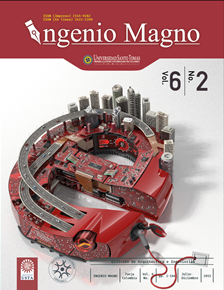Evaluation of susceptibility to mass wasting phenomena and use of geographical information systems for data processing
Main Article Content
Abstract
Downloads
Article Details
DECLARATION OF ORGINIALITY OF SUBMITTED ARTICLE
With this document, I/We certify that the article submitted for possible publication in the institutional journal INGENIO MAGNO of the Research Center Alberto Magno CIIAM of the University Santo Tomás, Tunja campus, is entirely of my(our) own writing, and is a product of my(our) direct intellectual contribution to knowledge.
All data and references to completed publications are duly identified with their respective bibliographical entries and in the citations thus highlighted. If any adjustment or correction is needed, I(we) will contact the journal authorities in advance.
Due to that stated above, I(we) declare that the entirety of the submitted material is in accordance with applicable laws regarding intellectual and industrial property, and therefore, I(we) hold myself(ourselves) responsible for any complaint related to it.
If the submitted article is published, I(we) declare that I(we) fully relinquish publishing rights of the article to the University Santo Tomás, Tunja campus. As remuneration for this relinquishment of rights, I(we) declare my(our) agreement to receive two (2) copies of the edition of the journal in which my(our) article appears.
References
Bautista, H. y Flores, R. (2006). Estudio morfométrico y morfodinámico de los sistemas de cárcavas en la zona norooccidental de la ciudad de Tunja (tesis de grado). Tunja: Universidad Pedagógica y Tecnológica de Colombia.
Bayona, J. M. y Amaya, M. (2004). Características de compresibilidad de suelos arcillosos del depósito fluvio lacustre de Tunja (tesis de grado). Tunja: Universidad Pedagógica y Tecnológica de Colombia.
Burrough, P. (1986). Principles of geographical information, systems for land resources assessment. 3.ed. Oxford, Claredon Press.
Brignardello, L. (1997). Proposición metodológica para la evaluación y zonificación integrada de riesgos naturales mediante la aplicación de Sistemas de Información Geográfica. Revista de Geografía Norte Grande, 24, 91-102.
Cáceres, L. (1999). Erosión por flujo superficial y sub-superficial en los alrededores de la ciudad de Tunja (tesis de maestría en Geotecnia). Bogotá: Universidad Nacional de Colombia.
Cartaya, S. y Pacheco, H. (2008). Metodología empleada para la zonificación de la susceptibilidad a los procesos de remoción en masa en cuencas de drenaje del estado Vargas, Venezuela. Revista de Investigación, 64(188), 162-164.
Dowla, F. y Rogers, L. (1996). Solving problems in environmental engineering and geosciences with artificial neural networks. Cambridge: MIT Press.
Guacaneme, J. (2006). Tunja: Zonificación de suelos en superficie de la ciudad de Tunja. Épsilon, 6, 34-40.
Herrera, E., Cañón, A. y Leal, J. (2013). Redes neuronales artificiales para representar la atenuación de la intensidad sísmica. Ing. Univ. Bogotá, 17(2): 277-292,
Instituto Geográfico Agustín Codazzi (IGAC) (1995). Suelos de Colombia: Origen, evolución, clasificación distribución y uso. Bogotá: Autor.
Jiménez, O. (2009). Metodología para la zonificación de la susceptibilidad y la amenaza por fenómenos de remoción en masa. Revista de la Facultad de Ingeniera UPTC, 19(28), 7-19.
Lee, S., Hyung, J., Min, K. y Sun, J. (2003). Landslide susceptibility analysis using GIS and artificial neural network. Earth Surface Processes and Landforms, 28, 1361-1376.
Martínez, E., Giraldo, A., Alarcón, E. y Zapata, J. (2006). Zonificación geotécnica del Valle de Aburrá usando redes neuronales artificiales. Medellín: Universidad Nacional de Colombia.
Ministerio de Ambiente, Vivienda y Desarrollo Territorial (2010). Reglamento colombiano de construcciones sismorresistentes (NSR-10). Bogotá: Autor.
Moreno, A. (2009). Desarrollo de una interfaz gráfica de redes neuronales usando Matlab. Madrid: Universidad Carlos III.
Ramírez, O. (1990). Zonificación Geotécnica de Tunja (tesis de maestría en Geotecnia). Bogotá: Universidad Nacional de Colombia.
Universidad Nacional de Colombia (2009). Amenaza, vulnerabilidad y riesgo por movimientos en masa, avenidas torrenciales e inundaciones en el valle de Aburrá. Medellín: Autor.

